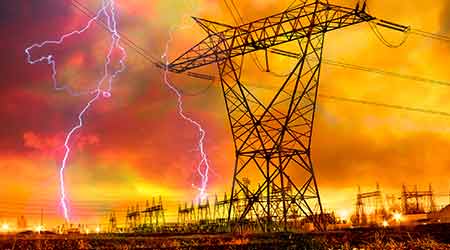Five Benefits of Energy Storage: The Holy Grail of Energy
First of a four-part Green Building Report.
Energy storage is often called the “holy grail” of energy. It’s regularly touted as a solution to fixing our aging power grid, a critical tool in increasing the spread of renewable energy, and a bridge between the needs of utilities and their customers.
The fact is, grid-connected energy storage is not a new concept, and it is commercially available today as a valuable tool for reducing electric bills, making facilities resilient, and earning revenue. Because energy storage solutions can be installed at many points in the grid, there are already tens of thousands of grid-connected storage systems installed at facilities throughout the world.
But what is energy storage, and how can it be put to use, today, in facilities across the country?
Currently, there are more than 150,000 megawatts of storage systems installed worldwide. Energy storage can refer to a wide range of technologies and approaches to managing power. There are a number of technologies relevant to commercial and industrial facilities, which can operate as standalone systems or in tandem with a solar PV installation:
• Solid-state batteries: Batteries are often paired with an intelligent software system that can charge and discharge them based on a building’s energy usage, weather patterns, and historical use patterns.
• Flow batteries: A type of rechargeable battery where energy is stored directly in the electrolyte solution; benefits typically include longer cycle life and fast response times.
• Flywheels: these systems store electricity in the form of kinetic energy. If power fluctuates or goes down, the rotor will continue to spin and the kinetic energy can be converted into electricity. Flywheels are useful for power quality and reliability.
• Thermal storage: Thermal technologies enable temporary energy reserves in the form of heat or cold. Ice storage, for example, works by making ice during off-peak hours when rates are low. When demand increases and rates go up, the ice system turns off the AC and uses the stored ice to provide cooling.
Five Benefits of Storage
Depending on factors such as a facility’s location, utility rates, and electrical load, energy storage can be an ideal solution for facilities to cut energy bills. The cost of energy storage systems is dropping constantly, while the number of installed customer-sited energy storage systems is increasing rapidly. According to GTM Research, there was a 142 percent increase in installed MWh from Q1 2015 to Q1 2016 in the customer-sited sector. They also expect nearly 50 percent of all deployments to be customer-sited by 2021. Let’s take a closer look at five benefits these resources can offer:
1. Environmental benefits. Energy storage has many environmental benefits that can make it a valuable tool for meeting sustainability goals. By improving the overall efficiency of the power grid, storage accelerates the broader adoption of renewable energy. On a more local level, an energy storage system has no emissions, so it can be placed anywhere in a facility with no immediate environmental or air quality impacts. And if paired with solar PV, not only will the power be GHG-free, the combined system is eligible for federal investment tax credits.
2. Demand charge reduction. Depending on location, many commercial and industrial facilities are subject to demand charges on their energy bills. These charges are based on the 15-minute period in which the demand for energy is highest throughout the day and in some cases, can account for 50 percent of the total energy bill. While energy efficiency or solar PV can reduce total electricity consumption, these benefits do not always coincide with a building’s peak use. Energy storage systems, especially those paired with intelligent software, can track a facility’s load and reduce demand charges by dispatching battery power during periods of peak demand, effectively “flattening” the load.
3. Participation in demand response programs. Demand response for commercial and industrial facilities traditionally involves ratcheting down usage at times of peak demand. Energy storage can enable participation in demand response markets without impacting on-site energy use or operations. By responding to utility price signals, storage systems can increase financial return from participating in DR programs, while also benefiting the grid overall.
4. Maximizing time-of-use rates. Energy storage systems can shift consumption of electricity from expensive periods of high demand to periods of lower cost electricity during low demand. This reduces the risk of lowering the value of on-site solar if tariff structures change over time, and peak demand periods shift to the evening when the sun isn’t shining. This also allows facilities to make the most of time-of-use pricing and reduce tariff structure change risk to electricity cost.
5. Emergency backup — resilience. Planning for emergency backup power is an essential part of a resilience plan. Historically, commercial and industrial facilities have invested significantly in local emergency backup infrastructure. With advanced storage solutions on the market today, there may be opportunities to upgrade this infrastructure to provide not only emergency backup, but also a host of other money-saving and money-making solutions. And by using this infrastructure on a daily basis for demand charge reduction, its reliability and availability in the event of an outage can be increased as compared to a standalone battery system and diesel generator that is only used during an outage.
Challenges of storage
For many facilities, energy storage is a new technology type that is both complex and diverse. Realizing all of the benefits requires a certain level of education for facility managers and owners. In addition, not all facilities pay utility rates that allow them to capitalize on these benefits, so financing and investment can present a challenge. Many storage companies offer no-money-down storage solutions to commercial and industrial customers, though, so this is a challenge that can be overcome with sufficient education.
Additionally, energy storage codes and standards have lagged behind the pace of technology innovation, leading to lengthy and costly interconnection and permitting processes. This is especially true for construction in existing buildings. Overall, energy storage can save and even make money for many types of facilities. However, currently, there is limited information available about the range of energy storage solutions, capabilities, and financing options on the market today. n
Janice Lin is the director and founder of the California Energy Storage Alliance and the founder and chair of the annual Energy Storage North America conference. She has more than two decades of experience in clean energy strategy, market development, and corporate strategy. As founder and managing partner of Strategen Consulting, she has advised a diverse range of clients including renewable energy equipment manufacturers and service providers, large corporations diversifying into clean energy, and real estate developers building sustainable communities.
Email comments and questions to greg.zimmerman@tradepress.com.
Related Topics:















